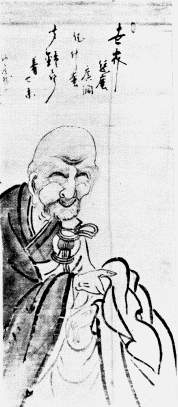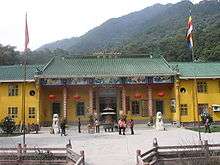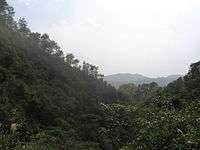Yunmen Wenyan
Yúnmén Wényǎn (862 or 864[1] – 949 CE; 雲門文偃; Japanese: うんもんぶんえん, Ummon Bun'en; also known in English as "Unmon", "Ummon Daishi", "Ummon Zenji"), was a major[lower-alpha 1] Chinese Chan master in Tang-era China. He was a dharma-heir of Xuefeng Yicun.[lower-alpha 2][lower-alpha 3]
Yúnmén Wényǎn | |
|---|---|
 | |
| Title | Ch'an-shih |
| Personal | |
| Born | 862 or 864 |
| Died | 949 |
| Religion | Buddhism |
| Nationality | Chinese |
| School | Ch'an |
| Part of a series on |
| Zen Buddhism |
|---|
 |
|
Persons Chán in China Classical
Contemporary
Zen in Japan Seon in Korea Thiền in Vietnam Zen / Chán in the USA Category: Zen Buddhists |
|
Doctrines
|
|
Awakening |
|
Practice |
|
Schools
|
|
Related schools |
Yunmen founded the Yunmen school, one of the five major schools of Chán (Chinese Zen). The name is derived from Yunmen monastery of Shaozhou where Yunmen was abbot. The Yunmen school flourished into the early Song Dynasty, with particular influence on the upper classes, and eventually culminating in the compilation and writing of the Blue Cliff Record.
The school would eventually be absorbed by the Linji school later in the Song. The lineage still lives on to this day through Chan Master Hsu Yun (1840–1959).
Biography
Early years
Yunmen was born in the town of Jiaxing near Suzhou and southwest of Shanghai[1] to the Zhang family [lower-alpha 4], apparently in 864 CE. His birth year is uncertain. The two memorial stele at the Yunmen monastery states he was 86 years old when he died in 949 CE, which suggests that he was born in 864 CE.
Initial Zen-studies
While a boy, Yunmen became a monk under a "Commandment master" [lower-alpha 5] named Zhi Cheng in Jiaxing. He studied there for several years, taking his monastic vows at age 20, in 883 CE.
The teachings there did not satisfy him, and he went to the school of Reverend Chen, Muzhou Daozong (also known as Bokushu.)[lower-alpha 6] to gain enlightenment. According to legend, first mentioned in 1100, he had his leg broken for his trouble:
Ummon [Yunmen] went to Bokushu's temple to seek Zen. The first time he went, he was not admitted. The second time he went, he was not admitted. The third time he went the gate was opened slightly by Bokushu, and thus Ummon stuck his leg in attempting to gain entrance. Bokushu urged him to "Speak! Speak!"; as Ummon opened his mouth, Bokushu pushed him out and slammed shut the large gate so swiftly that Ummon's leg was caught and was broken.
Daozong told Yunmen to visit the pre-eminent Zen master of the day,[4] Xuefeng Yicun of Mt. Hsiang-ku, in Fuzhou (Fukushū) in modern-day Fujian, and become his disciple, as by now, Daozong was too old (~100 years old) to further teach Yunmen. After a few years studying with him, Yunmen did so, and received after several years, enlightenment.
Advanced Zen-studies
While Yunmen had received his teacher's seal of approval, he nevertheless did not become abbot, probably because he had only stayed there for 4 or 5 years. When Xuefeng Yicun died, Yunmen began travelling and visited quite a number of monasteries, cementing his reputation as a Ch'an master.
During a subsequent visit to the tomb of the Sixth Patriarch in Guangdong, Yunmen eventually joined (c. 911 CE) the monastery of Rumin Chanshi/Ling-shu Ju-min, who died in 918 CE. They became great friends. With his death, Yunmen became head priest of the Lingshu monastery on Mt. Lingshu (Reiju-in).
In this Five Dynasties and Ten Kingdoms period, the T'ang dynasty was greatly weakened, and entire sections of the empire had broken away. The South was peaceful and developed, but the "North was torn by the ravages of war".[1] The area of Southern China where Yunmen lived broke free during the rebellion of Huang Chao, a viceroy of the Liu family. Eventually, the Liu family became the rulers of the Southern Han (918–978) kingdom during the Five Dynasties and Ten Kingdoms period. The ruler, Liu Yan, visited the monastery for Rumin's cremation (as Liu often sought Rumin's advice), and met Yunmen.
Abbot of Yunmen monastery

Impressed, Liu Yan extended him his patronage and protection, as well as confirming his appointment as the new abbot of the Lingshu monastery. But Yunmen's fame drew a great flow of visitors from all over China and even from Korea. All these visitors proved too distracting for Yunmen's taste, and in 923, he asked the king [lower-alpha 7] to aid him in building a new monastery on Mount Yunmen. The king acquiesced, and five years later, at the age of 64, Yunmen began living in and teaching in the monastery on the mountain from which he took the name by which he is best known.
While the king and some of Yunmen's disciples continued to try to give Yunmen more responsibilities and honors, Yunmen refused, and returned to his monastery.
Farewell
One day, when Yunmen was 85 or 86, he composed a farewell letter to his patron, the new king of the Southern Han, and gave a final lecture to his monks, finishing with the statement:
Coming and going is continuous. I must be on my way!
Yunmen then [lower-alpha 8] sat in a full lotus posture and died. He would be buried with great honors [lower-alpha 9], and his well-preserved corpse was exhumed several years later, and given a procession. In honor of this, his monastery was given a new name, and two stele erected, which recorded his biography. His corpse would be venerated until the 20th century, when it would disappear during the chaos of the Cultural Revolution.
Yunmen was succeeded as abbot by Dongshan Shouchu (Japanese: Tōzan Shusho; d. 900[5]). Suhotsu became abbot in 990 CE; although at the time, his foremost disciple was accounted Pai-yün Shih-hsing, who had founded his own temple on the nearby Mt. Pai-yün.
Teachings

How steep is Yün-mên's mountain!
How low the white clouds hang!
The mountain stream rushes so swiftly
That fish cannot venture to stay.
One's coming is well-understood
From the moment one steps in the door.
Why should I speak of the dust
On the track that is worn by the wheel?
— Yun-men, from the Jingde Chuandeng Lu
《景德傳燈錄》
Yunmen was renowned for his forceful and direct yet subtle teaching, often expressed through sudden shouts and blows with a staff, and for his wisdom and skill at oratory:
[He was] the most eloquent of the Ch'an masters.[6]
Yet, his teachings are also described as "difficult to understand":
Ummon's school is deep and difficult to understand since its mode of expression is indirect; while it talks about the south, it is looking at the north.[7]
One Word Barriers
Yunmen is known for apparently meaningless short sharp single word answers, like "Guan!" (literally, "barrier" or "frontier pass") – these were called "Yunmen's One Word Barriers". These one-word barriers
...were meant to aid practice, to spur insight, and thus to promote realization. Not only his punchy one-syllable retorts, but also his more extended conversation and stories came to be used as koan.[8]
Koans
An apocryphal anecdote that began circulating around the beginning of the 12th century has Yunmen going so far as to forbid any of his sayings or teachings from being recorded by his many pupils[lower-alpha 10]:
When Master Yunmen expounded the Dharma he was like a cloud. He decidedly did not like people to note down his words. Whenever he saw someone doing this he scolded him and chased him out of the hall with the words, "Because your own mouth is not good for anything you come to note down my words. It is certain that some day you'll sell me!"
As to the records of "Corresponding to the Occasion"[lower-alpha 11] and "Inside the Master's Room"[lower-alpha 12]: Xianglin and Mingjiao had fashioned robes out of paper and wrote down immediately whenever they heard them.[9]
Despite this, Yunmen is one of the greatest sources of "live words", "old cases", and paradoxical statements that would later evolve into the koan tradition, along with Zhaozhou (Japanese: Jōshū Jūshin).
Most were collected in the Yúnmén kuāngzhēn chánshī guǎnglù (雲門匡眞禪師廣錄).
Eighteen koans in the Blue Cliff Record involve Yunmen. Eight of Yunmen's sayings are included in Book of Equanimity, and five in The Gateless Gate.
Eighteen other koans were later discovered when a subsequent master of the Yunmen school, Xuetou Chongxian (Setchō Jūken, 980–1052 CE), published his Boze songgu, which contained one hundred "old cases" popular in his teaching line, in which the eighteen Yunmen koans were included.
Further examples can be found in the Ninden gammoku,[lower-alpha 13] and the Ummonroku.[lower-alpha 14]
While his short ones were popular, some of his longer ones were iconic and among the most famous koans:
Yun-men addressed the assembly and said: "I am not asking you about the days before the fifteenth of the month. But what about after the fifteenth? Come and give me a word about those days."
And he himself gave the answer for them: "Every day is a good day."[10]
Lineage
His disciples reputedly numbered 790, an unusual number of whom became enlightened. The Yunmen School flourished as one of the Five Schools for about 300 years, after which it was absorbed into the Linji school towards the end of the Southern Song dynasty (~1127 CE).
The lineage still lives on to this day through Chan Master Hsu Yun (1840–1959). He rebuilt the Yun Men temple and the 6th patriarchs temple Nan-hua Si. The Yunmen school continues through Master Hsu Yun, Fo Yuan, and Master Ming Zhao Shakya, who have disciples in America and abroad.[11]
Mention in contemporary media
Yunmen's Japanese name, Ummon, was the namesake for a character which was featured prominently in Dan Simmons' acclaimed Hyperion Cantos science fiction series; Simmon's Ummon was a vastly advanced, intelligent AI from the "TechnoCore", who reveals key plot elements to the main characters, through koans and mondo (dialogue).
See also
- Jingde (era) Record of the Transmission of the Lamp
- The Gateless Gate
- The Blue Cliff Record
Notes
- "Yun-men Wen-yen (864–949) was one of the most eminent Zen personalities of his time." pg 230, Dumoulin 1994.
- Or Hsueh-feng I-ts'un; Japanese: Seppo Gison
- Another famous disciple of Yicun would be Fa-yen Wen-i (885–958)[2]) (822–908), for whom Yunmen had served as a head monk.
- Later as a monk he would take the name Wenyan; to avoid confusion he will be referred to by his later name of "Yunmen"
- As Miura and Sasaki describe it, "Commandment master" is an unfortunate label borrowed from Christianity and is a misnomer. There are no "commandments" from God or Buddha in Buddhism.[3] "Commandment master" usually refers to a specialist in vinaya: monastic rules and discipline. Sørensen mentions that some sources say that Chih-Ch'eng/Zhi Cheng was actually a Ch'an master
- also known as Bokushu, Reverend Chen, Muzhou Daozong, Ch'en Tsun-su, Mu-chou Tao-tsung, Tao-ming, Muzhou Daoming etc.;[1] "an eccentric disciple of Huang-po" who practiced an extremely rigorous form of Zen in Mu-chou, after which place he was named[1]
- Liu Yan having died by this time[4]
- reputedly, in great pain because of his crippled leg
- but not as great as the state would have liked, as befitted a great master and spiritual minister of the state
- "What is the good of recording my words and tying up your tongues?" was one of his sayings
- the first chapter of The Record of Yunmen
- the first section of the second chapter of The Record of Yunmen
- Chinese: Jen-t'ien yen-mu, compiled by Hui-yen Chih-chao, a Lin-chi monk. He wrote a history of the Five Houses of Zen Buddhism: Yun-men, Ts'ao-tung, Kuei-yan, and Fa-yen, as well as his own, Lin-chi. See page 214 of Dumoulin 1994.
- Ummon Kyōshin zenji kōroku; Chinese: Yün-men K'uang-chen ch'an-shih kuang-lu; shorter: Ummon Ōsho kōroku. The most common abbreviation is just Ummonroku (Chinese: Yün-men lu), though. It was first published in three books in 1076. See page 241 of Dumoulin 1994.
References
- pg 230, Dumoulin 1994.
- pg 233, Dumoulin 1994
- Miura 1967.
- pg 231 of Dumoulin 1994
- pg 232, Dumoulin 1994.
- pg 213 of J.C.H. Wu's The Golden Age of Zen.
- Gyomay Kubose
- pg 232 of Dumoulin 1994.
- Ch'an Master Yunju of Foyin
- "Case 6. See k. Sekida, Two Zen Classics, p. 161", pg 232 of Dumoulin 1994.
- pg 233 of Dumoulin 1994.
Sources
- App, Urs (1989). Facets of the Life and Teaching of Chan Master Yunmen Wenyan (864–949). Ann Arbor: University Microfilms International.
- App, Urs (1994). Master Yunmen: From the Record of the Chan Master "Gate of the Clouds". New York: Kodansha International. ISBN 978-1-56836-004-1.
- App, Urs (1994). Zen-Worte vom Wolkentor-Berg. Darlegungen und Gespräche des Zen-Meisters Yunmen Wenyan (864–949). Bern / München: Barth. ISBN 978-3-502-64640-2.
- Miura, Isshuu; Sasaki, Ruth Fuller (1967). Zen Dust: The History of the Koan and Koan Study in Rinsai (Lin-Chi) Zen. Harcourt, Brace & World. LCCN 66010044.
- Kubose, Gyomay M. (1973). Zen Koans. Chicago: H. Regnery. ISBN 978-0-8092-9065-9. LCCN 72011183. OCLC 532206.
- Daoyuan, Shi; Zhongyuan Zhang (1971). Original teachings of Ch'an Buddhism: selected from The transmission of the lamp. New York, Toronto: Random House. ISBN 978-0-394-71333-5.
- Sørensen, Henrik Hjort. "The Life and Times of the Ch'an Master Yūn-men Wen-yan", pp. 105–131, Vol. 49 (1996) of Acta orientalia, ISSN 0001-6438
- Dumoulin, Heinrich (1994) [1988]. Zen Buddhism: A History; Volume 1, India and China; With a New Supplement on the Northern School of Chinese Zen. Translated by James W. Heisig, Paul Knitter (Second ed.). New York, NY: Macmillan Reference USA, imprint of Simon & Schuster Macmillan. pp. 387. ISBN 978-0-02-897109-4.
External links
- Zen Buddhism: An Introduction to Zen with Stories and Parables
- Ummon
- Transcription online of Pen-chi of Ts'ao-shan's Questions and Answers, as translated in Sources of Chinese Tradition (de Bary, Chan and Watson, ed. and trans.)